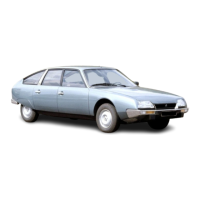Supplement
to Manual 818-1 ADD
--3
O"'
7i'
C-'
.+-
27'
,,.
C-'
Q"'
7G'
(/i
R.' roH .'-t-
'"F
Q..
Ö..
(fl
z
z
0
:-'
i..
OPERATION
N° MA.
450-00
(harriclerislics
non specmal
jQat//r('S (if
Ibc
brakiu
ssIcm
Op.
MA.
450-00
5
BRAKE
PRESSURE
LIMITER
(
Es/am ichicins
A brake pressure
limiter
is fitted
to the rear
broking
system on Estate
vehicies. 'ts
object is
to
vary
the maximum
pressure
in the rear
braking
system as a
function
of
the
bad
imposed
on
the
rear suspension.
ond the pressure
in
the
front
braking system.
It is secured
horizontally
on the
front subframe,
behind the
safety
valve.
L 45-6
0
0
4
ce
tO
77
0
z
0
77
E
77
77-
0
1)
L 45-6
OPERATION
(
Vc'h/cles
The brake
pressure
limiter
consists mainly
of a
slide-valve, the
positions
of
which allow
or
do not
allow
the
supply
of fluid under
pressure
from the
brake valve
to the rear
brakes.
The ends
of this
sijde-valve are submitted
to
the
action of
two forces
-
Force
F exerted
by
the
fluid under
pressure
in
the
reor suspension.
-
Force
R exerted
by
spring (1) and
increased by the
value of force Fl
exerted
by
the
front brake fluid
pressure during brciking action.
o
)
%,'ciic/cs in tbc
'
mii
p05111011
(
no /rcssi/rc
)
Under
the
only force
R,that of
the
spring.
slide-valve
is
in the
position indicated
in figure 1. The
fluid
cannot pass from the
brake vaive
to the rear
brakes,
and vice-versa
).
b
)
Vch id c in
ib c
«
no rio al
»
dr, iii,
o .5/1,01/. 7/0
action on brak»'
p
cdal
Force
F exerted
by
the rear
suspension
pressure
is
greater
than
Force
R
exerted
by
the
sprinq.
The
slide-valve is in
the
position
indicated
by
Figure
2,
which
aliows
flow
of
fluid
from
brake
valve to rear brakes
(
and
vice-versa
).
c
)
Vc/.ii
din in 77/0 tio,,
iii Ih Ii'»' brak c »'
r/al an/nain ni
Fluid
from
the
front
brakes
exerts a
Force
Fl
which is
added
to Force R exerted
by
the
spring.
When these
twa farces are
smaller
than
force
F,
slide-vaive is in position
shown in Fiqure 2.
The rear
brakes
are supplied.
When
these
twa
forces are greater
than
Force
F,
slide-valve
is in the
position
shown
on
Figure 1.
The rear
brakes are
not supplied.
NOTE
Fl
+ R
>
F
is true,
when the
pressure
in
the front brakes
+
28
bars
(
406
psi
)
becomes
greater than the
pressure
in
the
rear
suspension.
When
F
increases, Fl
increases.
Consequently,
maximum pressure
in
the rear
brakes
increases.
In
order ta
avoid a sudden
cut-out
of the supply
to
the rear
brakes, a ball-valve
siows the
flow
of
liquid
fram
the
front brakes. The action
of this
valve is increased by
the
fact
that
an
air-bubble
trapped in its chamber, secured at
the
rear
of
the
front
subframe upper.crossmember
on
the
L.H.
side,
has to
be compressed.
Once
the
slide-valve
has
started
maving, the
supply of fluid
is not slowed
down,
and
it
then
fbows through
the
by-pass channel.
PDF compression, OCR, web-optimization with CVISION's PdfCompressor

